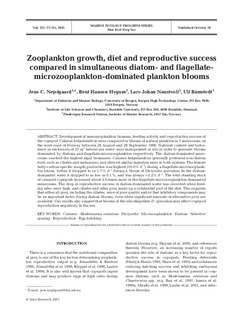| dc.contributor.author | Nejstgaard, Jens Christian | |
| dc.contributor.author | Hygum, Bent Hansen | |
| dc.contributor.author | Naustvoll, Lars-Johan | |
| dc.date.accessioned | 2010-11-30T14:50:58Z | |
| dc.date.available | 2010-11-30T14:50:58Z | |
| dc.date.issued | 2001-10-18 | |
| dc.identifier.issn | 0171-8630 | |
| dc.identifier.issn | 1616-1599 | |
| dc.identifier.uri | http://hdl.handle.net/11250/108424 | |
| dc.description | Journal homepage: http://www.int-res.com/journals/meps/ | en_US |
| dc.description.abstract | Development of mesozooplankton biomass, feeding activity and reproductive success of the copepod Calanus helgolandicus were compared in blooms of natural plankton in 7 mesocosms on the west coast of Norway between 28 August and 28 September 1996. Nutrient content and turbulence in enclosures of 27 m3 natural sea water were manipulated in situ in order to generate blooms dominated by diatoms and flagellate-microzooplankton respectively. The diatom-dominated mesocosms
reached the highest algal biomasses. Calanus helgolandicus generally preferred non-diatom food, such as ciliates and metazoans, and showed similar ingestion rates in both systems. The female body-carbon-specific nauplii production was highest (10.6% d–1) during a flagellate-microzooplankton
bloom, before it dropped to ca 1.7% d–1 during a bloom of Dictyocha speculum. In the diatomdominated water it dropped to as low as 0.1%, and was always <5.2% d–1. The total standing stock
of calanoid copepods increased about 2.6 times more in the flagellate-microzooplankton-dominated
mesocosms. The drop in reproductive success in diatom-dominated water was recorded when feeding rates were high, and ciliates and other prey made up a substantial part of the diet. This suggests that either all prey, including the ciliates, were of poor quality and/or that inhibitory components may be an important factor during diatom blooms, even when significant amounts of alternative prey are available. Our results also suggest that blooms of the silicoflagellate D. speculum may affect copepod reproduction negatively in the sea. | en_US |
| dc.language.iso | eng | en_US |
| dc.publisher | Inter Research | en_US |
| dc.subject | zooplankton | en_US |
| dc.subject | dyreplankton | en_US |
| dc.subject | reproduction | en_US |
| dc.subject | reproduksjon | en_US |
| dc.subject | copepods | en_US |
| dc.subject | copepoda | en_US |
| dc.title | Zooplankton growth, diet and reproductive success compared in simultaneous diatom- and flagellatemicrozooplankton-dominated plankton blooms | en_US |
| dc.type | Journal article | en_US |
| dc.type | Peer reviewed | en_US |
| dc.subject.nsi | VDP::Agriculture and fishery disciplines: 900::Agriculture disciplines: 910::Livestock breeding, rearing, reproduction: 912 | en_US |
| dc.subject.nsi | VDP::Mathematics and natural science: 400::Zoology and botany: 480::Marine biology: 497 | en_US |
| dc.source.pagenumber | 77-91 | en_US |
| dc.source.volume | 221 | |
| dc.source.journal | Marine Ecology Progress Series | |
| dc.identifier.doi | http://dx.doi.org/10.3354/meps221077 | |
